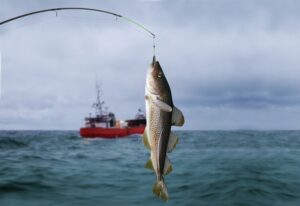Cape Cod is named for the fish that for centuries was extremely abundant in these waters and became the focal point of a major fishery that is no more. I’ve been thinking lately about whether there’s any hope for its return.
Bartholomew Gosnold, the English privateer who was the first recorded European to come to these shores — though it was already clear to him at the time that indigenous people had met other explorers and traders — named this place during his 1602 expedition. After landing in what is now Maine, his ship came down the coast to the tip of this peninsula and explored the bay before going around to the back side. Gabriel Archer, who chronicled the expedition, wrote that at first they named the bay Shoal Hope. But then, “we took great store of codfish, for which we altered the name, and called it Cape Cod.”

For a while, things didn’t change too much. When I was a young lad working on party fishing boats out of my hometown harbor in Brielle, N.J., I had the pleasure of being on board when an 81-pound codfish was caught. It was a world record at the time, 1967, one that has since been broken but still remains the state record for the species in New Jersey.
At the time, we were fishing an area so inundated with Russian trawlers that it was known as Red Square by local commercial fishermen. This was before the 200-mile limit was imposed for those big boats, of course — that came, in its limited way, in 1975.
I also remember coming up as a kid to take part in the amazing spring flounder fishing that went on every year in Quincy Bay. When we got tired of catching flounder, we would go out to deeper waters for a bunch of codfish to round out our catch. Like the song says, “Those were the days my friend — we thought they’d never end,” but end they did.
So what happened?
Overfishing both locally and by the intrusion of huge foreign factory fishing ships is what happened. The story is one of massive mismanagement. By the time the 200-mile limit was enacted in 1975, the Russian factory ships had pretty well cleaned us out. The government finally announced a moratorium on cod fishing in 1992. That was supposed to be in force for only two years, though regulators here and in Canada began to realize they had radically underestimated the problem.
Catches remained very low, so the fishery remained closed longer and is still extremely limited. Currently the regulations in Massachusetts for commercial fishing are a 19-inch minimum and a 400-pound maximum catch per day in the Gulf of Maine. There is a little higher limit in southern New England waters. But although some cod are caught here, there aren’t enough to make targeting them worth the effort for local fishermen. Iceland and Norway have had a better rebound, but their fishery didn’t have the same kind of collapse ours did.
Recreational catches are limited to one fish per day with a minimum size of 22 inches. Occasionally we hear of a cod being caught by someone haddock fishing up on the bank. But with the fish we target on boats like mine, we won’t catch a cod even accidentally.
Atlantic codfish can live up to 20 years. They can grow big, up to 60 inches and 90 pounds. They become sexually mature at two to three years old, when they are between 12 and 16 inches long. Larger females can produce 3 to 9 million eggs when they spawn, and they are at the top of the food chain as far as bottom dwelling fish go.
Although agencies vary on what the current stock assessments mean, NOAA feels like signs point to codfishing very slowly rebounding in our area. Their data show the 2016 to 2020 class of fish have slightly increased compared to before 2016. There are signs that cod numbers are on the rise from their all-time low in 2014, with the most recent state trawling survey in 2021 showing an uptick of juvenile fish. But we’re still talking about stocks that are around a tenth of what they once were.
What’s different now compared to even 20 years ago in terms of external pressures on these fish is that we have warming oceans. I’ve said this before: I believe we’ll come to see that the extreme proliferation of seals in our area is also a factor. So instead of just one headwind, overfishing, we have a triple threat that could potentially undermine the recovery of the species.
NOAA has control over only one of those factors. Its goal for complete restoration of codfish through the current management plan is 2033-2036. That’s rather ambitious if you ask me. Time will tell.



